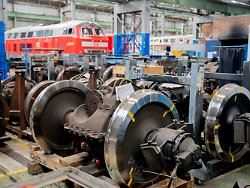In the coming years, many jobs will be lost in Lusatia due to the coal phase-out. The railway now wants to massively convert its plant there and set up a research center. Europe's most modern and environmentally friendly maintenance facility is planned.
With hundreds of new jobs in Lusatia, Deutsche Bahn wants to promote structural change in the region after the coal phase-out. The railway works in Cottbus are to be massively modernized and expanded. This creates a total of 1200 jobs, as the state company announced. Federal Finance Minister Olaf Scholz, Federal Transport Minister Andreas Scheuer and DB Board Member Ronald Pofalla have presented corresponding plans.
"Here we are implementing something that shows how structural change can work in concrete terms," said Scholz. "There is not only one Gigafactory in Brandenburg, there is now a second time too," said Scheuer about the project, referring to the emerging plant of the car manufacturer Tesla at the gates of Berlin. The plant is the first major project to be financed on the basis of the Federal Structural Strengthening Act. The law has been in force since August.
New hall and university cooperation
The railway plans to start building the plant in 2023. A new ICE hall for the maintenance of electric multiple units (ICE 4) is planned at the site of today's Cottbus railway works. 1100 new industrial jobs and 100 trainee positions are planned for the next three years. A hall is to be built for converting diesel vehicles to hybrid technology with electric drive. A technology center for hybrid research and modern training workshops are also planned. The railway wants to work together with the Brandenburg Technical University Cottbus-Senftenberg (BTU).
According to the company, it will be the most modern and environmentally friendly railway maintenance facility in Europe. "Robots, learning machines and artificial intelligence radically shorten the time spent in the workshop for ICE trains," explained Sabina Jeschke, DB Board Member for Digitization and Technology in Cottbus. The vehicles could get back on track more quickly.
With the new plant and more than twice as many jobs, capacities would be enormously expanded. This is necessary because the ICE fleet is to grow to more than 420 vehicles by 2026, according to Jeschke. According to Scheuer, this involves an investment of one billion euros.
. (tagsToTranslate) Economy (t) Coal exit (t) Deutsche Bahn (t) East Germany (t) Olaf Scholz
